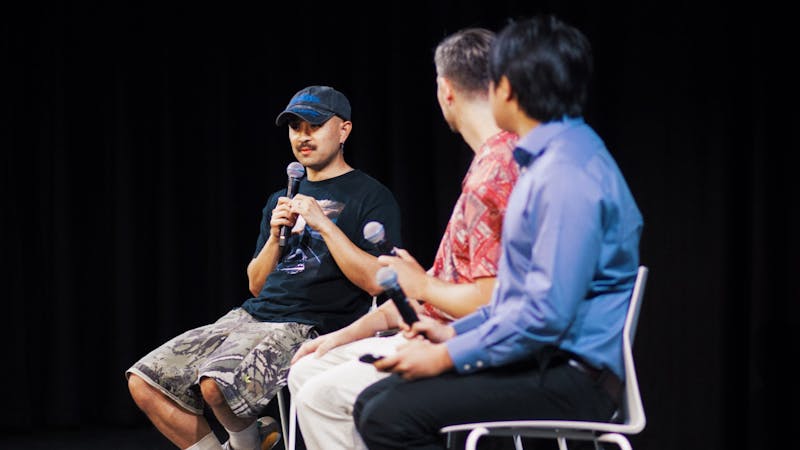A plywood mindscape

Henrique Oliveira's plywood installation, Tapumes, appears to warp time and space, despite being held together by mostly staples.
This week Henrique Oliveira arrives at Rice for his first solo exhibit in the U.S., and with him he brings most of the salvageable plywood siding from his neighborhood construction sites in Sao Paolo, Brazil.Oliveira, only 35 years old, has found an ingenious and altogether stunning way of presenting the found object medium, plentiful in the surroundings in which he lives. Gathering it at construction sites or among the refuse of shantytown housing, known in Portuguese as favelas, the piles of painted and weathered plywood strips, organized by color, size and texture, covered the floor of the gallery in the weeks preceding the opening. At the audience's feet are what Oliveira calls "the fractured image of a painting" that he began to assemble during the days preceding the exhibit's opening.
Oliveira confessed that his experimentation with wood began somewhat accidentally. Originally used as a support for his paintings, Oliveira said he liked the idea of using wood as a varied pallet with a wide range of colors and textures. The layers of painted plywood, particularly in his found pieces, had begun to flake of and reveal the various stages of its lifecycle.
Noticing "how broken layers of plywood could be seen as a brushstroke," Oliveira discovered these layers, complex surfaces and textures forming well beyond the limits of paint on canvas. Utilizing the multi-layering, his works take on the aspect of a sculptural painting.
There is always a delicate struggle in testing just how far the artist can warp and mold the wood. It is a complicated and fickle medium. The artist must learn to bend to his medium also, because his control over it is limited. Something is left up to chance, to the will and temperaments of the material itself.
At a glance it is an utter confusion of movement and color. From close proximity, one notes the painstaking labor that went into hashing together these starkly different pieces of refuse with either staples the placement of carefully interlocked strips of wood.
The exhibit itself is stunning. It is seemingly self-generative and organic in the way it emerges from the white walls of the gallery, receding back into itself over and over in constant flux. The colors of autumn on the sun-blanched wood mingle with the turquoises and blues of shallow cerulean seas to form this rich tapestry of colors and textures. What looks like the worn-down hull of an old ship rotates in on itself, expanding out, taking on more the shape and strength of the roots of a tree.
The curves and bends of the wood seem to defy not only the nature of such a brittle and rigid medium, but also the norms of dimensional space itself. Points of incomprehensible gravitational force pull these complex forms in unpredictable directions. Domes of wood and lacquered paint fold out and then back in on themselves, pushing the three dimensions to their visual extremes.
Certain elements jut out further. With what appear to be giant cloves of blue-green garlic and a hanging spire that twists and contorts itself beforecoming to a point, these features come straight out of a surrealist landscape.
What is inescapable is the overwhelming sense of urban-meets-natural. The infinity of unguided movement and unbridled colors bespeaks an immense and indecipherable joy of life.
From the initial medium - hard, brittle fragments of the post-industrial city - Oliveira creates constantly moving images of fluidity that belie the nature of the space they inhabit. The idea of chaos in the mental landscape is intriguing, and can be viewed as a reflection of the city of Sao Paolo in which the artist lives.
Somehow, Oliveira is raising the question of the quality of the relationship between man and nature, and the degree to which we coexist or clash. He is, after all, working with a medium that is removed, recycled and then once more reassembled into something that is decidedly natural and lifelike. As he describes it, his is a "natural material that has been processed and turned into societal rubbish," and through a sort of artistic reclamation, it is "brought back into an idea of nature."
Oliveira's goal, he modestly admits, is neither to initiate nor discourage the societal and philosophical discourses that will naturally be inspired by his work. His idea is not to make a statement on poverty or urban decline, but merely to present an art form in a new light and from a different perspective.
Oliveira's Tapumes opened yesterday at the Rice Gallery. Today at noon a reception with light refreshments will be held with the artist, allowing students the opportunity to ask questions and view the artist's U.S. debut.
More from The Rice Thresher

Worth the wait: Andrew Thomas Huang practices patience
Andrew Thomas Huang says that patience is essential to being an artist. His proof? A film that has spent a decade in production, a career shaped by years in the music industry and a lifelong commitment to exploring queer identity and environmental themes — the kinds of stories, he said, that take time to tell right.

Andrew Thomas Huang puts visuals and identity to song
Houston is welcoming the Grammy-nominated figure behind the music videos of Björk and FKA twigs on June 27.

Live it up this summer with these Houston shows
Staying in Houston this summer and wondering how to make the most of your time? Fortunately, you're in luck, there's no shortage of amazing shows and performances happening around the city. From live music to ballet and everything in between, here are some events coming up this month and next!

Please note All comments are eligible for publication by The Rice Thresher.